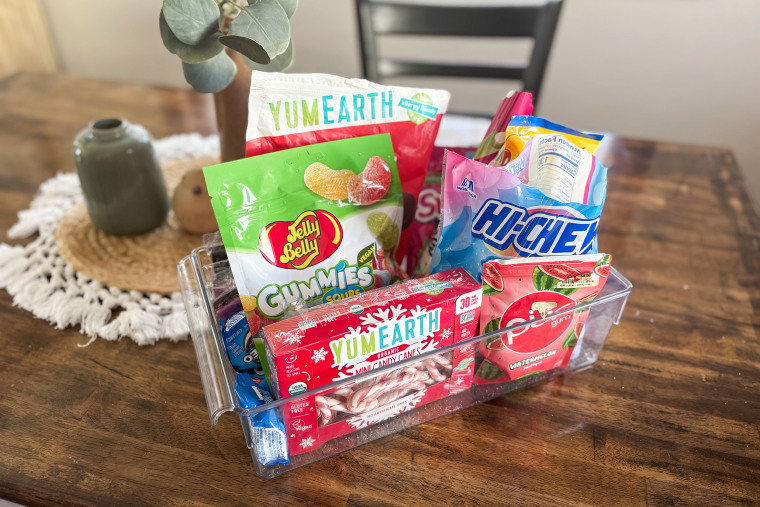Across the U.S., a longtime push to ban synthetic dyes in food is gaining renewed momentum, with critics of the dyes insisting it’s not a matter of if, but when.
States like West Virginia have cited the Make America Healthy Again movement, led by Health and Human Services Secretary Robert F. Kennedy Jr., as a driving force, along with concerns among parents and some scientists that dyes might contribute to behavioral problems in kids — a link the Food and Drug Administration says it is monitoring but hasn’t established.
In the first three months of the year, 20 states — including Oklahoma, West Virginia and New York — have introduced nearly 40 bills aimed at cracking down on artificial dyes and other food additives, the most in any year, according to the Environmental Working Group, a food safety advocacy group.
“We’re really encouraged,” said Brandon Cawood, an advocate for eliminating food dyes who, along with his wife, Whitney, created “To Dye For: The Documentary,” a film that has been cited by West Virginia lawmakers. “Oklahoma, Utah, Tennessee have bills on the table. Florida, New York, Texas, Arizona. All these states all over the place are popping up.”
The FDA has approved 36 color additives, including nine synthetic dyes used in foods and beverages. Among them was Red No. 3, approved for use in foods in 1907, though the agency banned it in January over concerns about possible cancer risks.
They’re commonly used in products marketed to kids, including candy, breakfast cereals and soda, because their bright, vibrant hues are particularly eye-catching, experts say.
Earlier this month, West Virginia lawmakers passed a bill banning seven of those dyes — including Red No. 40 and Green No. 3 — which is set to take effect in 2028 if signed into law by the state’s governor. The bill follows a similar move from California last year that banned six dyes from food served in public schools.
On Wednesday, Arizona lawmakers held a roundtable discussion on a bill that would ban public schools from serving or selling foods that contain certain chemicals, including synthetic dyes.
Kennedy’s push to eliminate artificial dyes
“There really hadn’t been much of a grassroots movement … and that shifted this election cycle,” said Jerold Mande, an adjunct professor of nutrition at the Harvard T.H. Chan School of Public Health, who is also a former FDA senior adviser and former deputy undersecretary for food safety at the Agriculture Department. “I really think MAHA is playing a big role in this.”
It’s by no means a new movement: The FDA began taking steps to look into a possible link between dyes and behavioral problems in kids in the 1970s, when a California allergist and pediatrician proposed a possible connection. The agency investigated it even further following a 2007 study published in The Lancet, which said artificial dyes resulted in increased hyperactivity in kids.
In 2011 and 2019, the FDA also reviewed data but determined no causal relationship could be established for children who haven’t already been diagnosed with behavioral disorders. Scientists and physicians have called for more research on the topic. The FDA did not respond to a request for comment. The FDA has said that it “has reviewed and will continue to examine the effects of color additives on children’s behavior.”
While the FDA hasn’t made a connection, that hasn’t stopped government officials and outside groups from insisting there is one — or alleviated concerns from parents.
“It’s extremely important that we really change our school food,” West Virginia state Del. Evan Worrell said on a call with reporters Tuesday. “We have some behavioral problems in our school system today, and I’m not going to point them all to food dyes, but it’s a contributing factor.”
Kennedy, who oversees the FDA, has also previously claimed dyes are linked to hyperactivity and learning disorders. He cited a 2021 report from the California Office of Environmental Health Hazard Assessment that reviewed 27 trials in children and concluded food dyes can interfere with normal behavior in some kids.
He is vowing to eliminate artificial dyes from the nation’s food supply, telling executives from major food companies in a closed-door meeting this month that he wants them all gone by the end of his term, according to an HHS official. It’s unclear whether he’ll have the money or resources to do so, however, given the Trump administration’s broader goal of reducing federal spending across the government.
Other dyes permitted by the FDA include Red No. 40, used in cereals, gelatins and puddings; Yellow No. 5, used in snacks, condiments, baked goods and yogurt; and Green No. 3, used in ice cream, sherbet and drink mixers.
The FDA’s slow efforts to take action on artificial dyes has forced states and local groups to step up, said Marion Nestle, professor emerita of nutrition, food studies and public health at New York University.
State lawmakers also point to other countries, like those in Europe, where food dyes are more heavily regulated.
Still, Nestle added, any action the FDA takes to ban certain chemicals must be based on sound scientific evidence showing a potential link. The agency’s ban on Red No. 3 was based on research linking the chemical to cancer in laboratory rats. Although there wasn’t evidence in humans, it was enough to persuade the FDA.
While some research has suggested a link between certain dyes and an increase in hyperactivity and moodiness or irritability in children, the evidence still isn’t conclusive, which may explain why the FDA is taking so long, Nestle said.
“The research is really, really hard to do,” said Nestle, questioning how Kennedy would go about banning the chemicals. “You can’t do it in people. You can’t take a bunch of kids and give some of them food dyes and another bunch of kids not and see what happens.” She noted there’s evidence that some kids respond badly to color dyes.
Even so, it may become harder for food companies to defend the use of the chemicals — especially because they don’t preserve food or provide a nutritional benefit, Nestle said.
In a statement, Sarah Gallo, senior vice president of product policy for the Consumer Brands Association, an industry trade group, said food and beverage makers are committed to food safety and criticized a state-by-state approach.
“A state patchwork approach in the food regulation space creates unnecessary confusion for consumers, limits access to everyday goods and increases costs at the grocery store,” Gallo said.
Mande, of Harvard, said he doesn’t buy arguments from some food companies about the potentially high cost of transitioning away from synthetic dyes, noting companies have managed to find “natural” color additives to replace them in other countries where synthetic ones are banned.
Nestle said some companies have tried to eliminate artificial dyes from their products in the past, although unsuccessfully.
Mars announced a plan in 2016 to remove artificial dyes from all its products but abandoned the pledge in 2021, stating: “We have found that consumer expectations regarding colors in food differ widely across markets and categories.”
General Mills also made a switch to natural dyes in its cereals in 2016 but brought back artificial colors a year later after consumers reportedly complained the new colors were depressing.
“We don’t really need these things. Their only function is cosmetic,” Nestle said. “Should we use the European precautionary principle: If we can’t prove that these things are safe, then we’re just not going to use them?”
That’s the path Wendy Bakos, 34, from Florida, took when she transitioned her two children, Harper, 7, and Caden, 3, away from foods containing artificial dyes about a year ago.
Concerned about possible health issues from dyes, she joined a Facebook group of families who’ve made a similar transition that lists resources and recipes.
The most challenging part of the transition, she said, was finding dye-free candy that her children liked, particularly Harper.
They did find alternatives, however, like a brand called Unreal, and discovered that Trader Joe’s offers candy without artificial dyes.
“We weren’t really eating too much, like say, Froot Loops and things,” Bakos said. “With candy, especially like on Halloween, it was like, ‘Wait a second, why can’t I eat that?’ But as soon as I introduced her to alternatives, she was fine with it.”

Likewise, Liz Dent, 36, from Humboldt, Iowa, didn’t find a lot of issues when she stopped buying foods with dyes for her kids Evelyn, 9, and Ella, 6. Their family, she says, has been dye-free since 2021.
Dent sends her children to school with dye-free candies, suckers and fruit snacks. She also always keeps a box of juice boxes and popsicles.
The hardest part of the transition, she said, was attending events, like birthday parties.

“When we’re at special events, like a theme park or a fair, if we go to Disney World, we just have to bring our own food,” Dent said. “If we go somewhere, and everybody else can have a snow cone, my kids can’t have it. My kids can’t have the cotton candy. My kids can’t have cookies or ice cream.”



